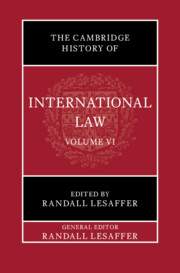Book contents
- The Cambridge History of International Law
- The Cambridge History of International Law
- Frontispiece
- The Cambridge History of International Law
- Copyright page
- Contents
- Plates
- Contributors
- Preface
- Abbreviations
- Part I International Law in Renaissance Europe (1492–1660)
- 1 The Law of Nations in Renaissance Europe
- 2 Territory and Jurisdiction in Renaissance Europe
- 3 Beyond the Free Sea
- 4 War and the Use of Force in Renaissance Europe
- 5 Warfare on Land in Renaissance Europe
- 6 The Law of Maritime Warfare during the Transition between Medieval and Early Modern Europe
- 7 Peacemaking in Renaissance Europe
- 8 Trade and Navigation in Renaissance Europe
- 9 Diplomacy in Renaissance Europe
- 10 Dispute Settlement in Renaissance Europe
- 11 The Ottoman Encounter and the Law of Nations in the Renaissance
- Part II International Law in Old Regime Europe (1660–1775)
- Index
- Plate Section (PDF Only)
- References
2 - Territory and Jurisdiction in Renaissance Europe
from Part I - International Law in Renaissance Europe (1492–1660)
Published online by Cambridge University Press: 22 April 2025
- The Cambridge History of International Law
- The Cambridge History of International Law
- Frontispiece
- The Cambridge History of International Law
- Copyright page
- Contents
- Plates
- Contributors
- Preface
- Abbreviations
- Part I International Law in Renaissance Europe (1492–1660)
- 1 The Law of Nations in Renaissance Europe
- 2 Territory and Jurisdiction in Renaissance Europe
- 3 Beyond the Free Sea
- 4 War and the Use of Force in Renaissance Europe
- 5 Warfare on Land in Renaissance Europe
- 6 The Law of Maritime Warfare during the Transition between Medieval and Early Modern Europe
- 7 Peacemaking in Renaissance Europe
- 8 Trade and Navigation in Renaissance Europe
- 9 Diplomacy in Renaissance Europe
- 10 Dispute Settlement in Renaissance Europe
- 11 The Ottoman Encounter and the Law of Nations in the Renaissance
- Part II International Law in Old Regime Europe (1660–1775)
- Index
- Plate Section (PDF Only)
- References
Summary
This chapter describes territorial conflicts among lords, parishes, cities and towns, and how they contributed to emerging notions of the territoriality of states. It surveys debates regarding both the expansion to new territories and the conservation of existing territories and considers how these debates operated both in Europe and in European overseas colonies. It analyses the writing of jurists as well as a plethora of practices that contemporaries pursued, which despite their obvious local reiterations, were mostly pan-European. Among other things, it covers the question of just war, taking possession of not yet occupied land, discovery, prescription, conservation of the status quo and the role of both conflicts and agreements, including agreements with indigenous peoples, natural law, the law of nations and of relations between territory and jurisdiction. To explain developments during the Renaissance, it observes a much longer time span that began in the Middle Ages and allowed for both slow and revolutionary transformations. It shows that developments in Europe were important, but as vital in both encouraging and empowering change was colonialism, which affected many peoples and territories across the world but also modified Europe in ways we have not yet completely understood.
- Type
- Chapter
- Information
- The Cambridge History of International Law , pp. 58 - 106Publisher: Cambridge University PressPrint publication year: 2025

